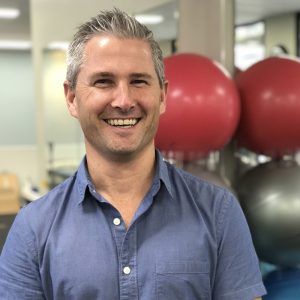So what is “core” exactly?
 What is core stability?
What is core stability?
This word ‘core’ gets thrown around very easily these days.
Depending on who you are engaged with such as your Personal Trainer, a Yoga or Pilates instructor or a Physiotherapist, you may get a very different answer to the question. This brief article will hopefully clear up this concept termed ‘core’.
The principle of ‘core’ can actually be applied to all joints of the body but it is fair to say that most people associate ‘core stability’ with low back pain.
In short, there are two types of muscle in the body with two very distinct functions.
‘Phasic’ or ‘Power’ Muscles
The first are called ‘phasic ’ or ‘power’ muscles. This type of muscle is what gives you your power. A good example is the biceps muscle of the arm. It can generate large amounts of torque to help push and pull objects. It is these muscles we are generally working when at the gym or out for a run a swim or cycle. They are good for short periods but they tire easily which makes them undesirable for everyday simple tasks like sitting at your desk or standing at a set of traffic lights.
‘Tonic’ or ‘Postural’ Muscles
If we delve much more deeply into the body, right down to the deepest point where we are actually touching the joint line where the two bones meet to form the joint we have our second type of muscle we call ‘tonic muscle’ or otherwise referred to as ‘postural muscle’. This type of muscle is not very strong but has tremendous endurance that can last for all of your waking hours. These muscles which generate only very low forces create just the right amount of force to lightly bring the two bones together and optimally stabilise the joint without over-compressing it. It makes sense that when we move, the ‘power’ muscles do the forceful pushing and pulling whilst the stabilising or ‘core’ muscles hold the two bones of the joint together thus safely protecting the joint from potential injury during the movement. This gives us optimal dynamic stability.
Pain often inhibits or switches off core muscles at the affected joint
A great problem physiotherapists deal with everyday is that pain often ‘inhibits’ or ‘switches off’ the core muscles at the affected joint. To compensate for this weakness one or more of the adjacent much larger ‘power’ muscles attempts to take on a new ‘postural’ role and over-braces the joint.
In other words this over-compensatory muscle pattern grossly limits joint movement by adversely over-compressing the two bones together creating further pain and dysfunction.
Joint pain typically comes from too much compession
Any physiotherapist will tell you that nine times out of ten; joint pain typically comes from too much compression. This is usually when they are sharpening their elbow getting ready to release your large power orientated gluteus muscles!
Let’s consider the shoulder as a good example of ‘core’. As you initiate an arm movement, for example, picking up a pen, the ‘core’ muscles of the shoulder (called the rotator cuff) pre-emptively contract and act to centre the ball in the socket of the joint ensuring its stability whilst the arm is moving. This deep core contraction occurs in synchrony with the much larger torque producing ‘power’ muscles (e.g. biceps) in a type of ‘inter-muscular chit-chat’ to ensure safe and fluid movement with minimal risk of injuring the joint.
All joints have a ‘core’
As I mentioned all joints have a ‘core’. For the knee it’s the VMO (vastus medialis obliquus), for the ankle it’s the peroneals, the elbow it’s anconeus and the list goes on. For the area of greatest interest – the low back and pelvic region, of which we have 35 muscular options, only three are considered to be our ‘core’. These muscles include our fourth and deepest stomach muscle Transversus abdominus, our deepest of all spinal muscles Multifidus and the front (or anterior) pelvic floor muscle called pubococcygeus. These muscles collectively act to support the spine pre-emptively ‘switching on’ prior to any movement you make.
It is these muscles that you should think of as your ‘CORE’.
So let’s clear up some misconceptions. Unfortunately, performing the plank is not core; it’s a power muscle exercise. Sit-ups and crunches …no, again these exercises are for power.
The supportive ‘postural’ muscles work all day long
True core training is difficult. Perhaps the main reason it is so difficult is because they are supportive ‘postural’ muscles which work all day, not ones you usually think about. They sure aren’t as aesthetically pleasing as the old ‘six-pack’ muscle but they do protect the spine from injury and help with recovery from an injury.
When was the last time you stood at a set of traffic lights and thought “is my transeversus abdominus working”, or sat at your computer screen thinking “is my multifidus firing”? Not many people would, but unfortunately poor habitual postures either in standing or sitting does have a tendency to weaken the effectiveness of these muscles.
Real-time Diagnostic Ultra-Sound Machine for Core Stability Testing at MGS Physiotherapy
To make understanding core a little easier, MGS have in their possession a real-time diagnostic ultra-sound machine. This machine is the same type of machine an obstetrician would view a growing baby. This machine allows us to show you your ‘core’ on a screen whilst you are contracting these muscles (or not).
The physiotherapist’s at MGS use this machine for almost every low back pain patient as part of their treatment particularly in the hyper-mobile patient or the chronic long term low back pain patient to help give them (the therapist) and the patient as much information as possible about their client’s condition.
Arrange a ‘core’ assessment with MGS Physiotherapy
However, you may wish to have your own ‘core’ assessment and this can be arranged by simply phoning our reception staff and informing them you would like to book an ultra-sound assessment. This will ensure the machine is booked for your session. The cost is the same as that of a normal physiotherapy consult and lasts 30 minutes. It is covered as per usual by HiCaps if you are a member of a private health fund and covered for physiotherapy treatment. Remember to bring your thinking cap to this assessment because there are often lots of things to learn!
Some food for thought:
Do you hold your breath to pick up your shoes in the morning?
Are your hamstrings or hip flexors chronically tight?
Are you gripping your buttock right now?
These are all compensatory strategies to substitute for a weak or absent core…. perhaps this is a lecture for another MGS news article.
Written by Scot Thorn
MGS Physiotherapy
 This article was written by Titled Musculoskeletal Physiotherapist, Scot Thorn. Scot is a highly qualified and recognised Physiotherapist. He finished his first Science degree in the late 90’s when he majored in Anatomy and Physiology. He then undertook a Physiotherapy degree which he finished in 2003. In 2008 Scot finished his Masters degree in musculoskeletal physiotherapy.
This article was written by Titled Musculoskeletal Physiotherapist, Scot Thorn. Scot is a highly qualified and recognised Physiotherapist. He finished his first Science degree in the late 90’s when he majored in Anatomy and Physiology. He then undertook a Physiotherapy degree which he finished in 2003. In 2008 Scot finished his Masters degree in musculoskeletal physiotherapy.
Scot is indeed very highly and practically educated as a Physiotherapist. If the rest of the physios’ want to know something they don’t go back to the text books they just ask Scot.
